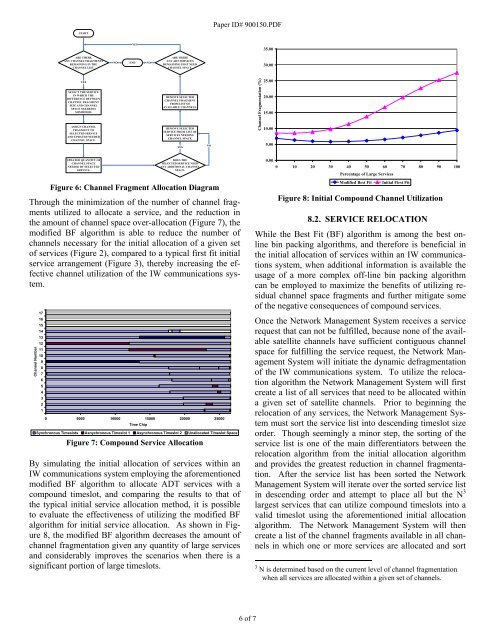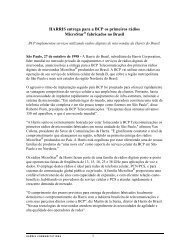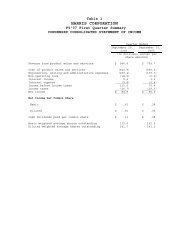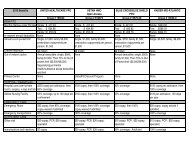METHOD OF ALLOCATING MULTIPLE ASYNCHRONOUS DATA ...
METHOD OF ALLOCATING MULTIPLE ASYNCHRONOUS DATA ...
METHOD OF ALLOCATING MULTIPLE ASYNCHRONOUS DATA ...
You also want an ePaper? Increase the reach of your titles
YUMPU automatically turns print PDFs into web optimized ePapers that Google loves.
START<br />
ARE THERE<br />
ANY CHANNEL FRAGMENTS<br />
REMAINING IN THE<br />
CHANNEL LIST.<br />
YES<br />
SELECT THE SERVICE<br />
IN WHICH THE<br />
DIFFERENCE BETWEEN<br />
CHANNEL FRAGMENT<br />
SIZE AND CHANNEL<br />
SPACE NEEDED IS<br />
MINIMIZED.<br />
ASSIGN CHANNEL<br />
FRAGMENT TO<br />
SELECTED SERVICE<br />
AND UPDATED NEEDED<br />
CHANNEL SPACE.<br />
UPDATED QUANTITY <strong>OF</strong><br />
CHANNEL SPACE<br />
NEEDED BY SELECTED<br />
SERVICE.<br />
NO<br />
YES<br />
END<br />
NO<br />
ARE THERE<br />
ANY ADT SERVICES<br />
REMAINING THAT NEED<br />
CHANNEL SPACE.<br />
REMOVE SELECTED<br />
CHANNEL FRAGMENT<br />
FROM LIST <strong>OF</strong><br />
AVAILABLE CHANNELS.<br />
REMOVE SELECTED<br />
SERVICE FROM LIST <strong>OF</strong><br />
SERVICES NEEDING<br />
CHANNEL SPACE.<br />
YES<br />
DOES THE<br />
SELECTED SERVICE NEED<br />
ANY ADDITIONAL CHANNEL<br />
SPACE.<br />
Figure 6: Channel Fragment Allocation Diagram<br />
Through the minimization of the number of channel fragments<br />
utilized to allocate a service, and the reduction in<br />
the amount of channel space over-allocation (Figure 7), the<br />
modified BF algorithm is able to reduce the number of<br />
channels necessary for the initial allocation of a given set<br />
of services (Figure 2), compared to a typical first fit initial<br />
service arrangement (Figure 3), thereby increasing the effective<br />
channel utilization of the IW communications system.<br />
Channel Number<br />
17<br />
16<br />
15<br />
14<br />
13<br />
12<br />
11<br />
10<br />
9<br />
8<br />
7<br />
6<br />
5<br />
4<br />
3<br />
2<br />
1<br />
0 5000 10000 15000 20000 25000<br />
Time Chip<br />
Synchronous Timeslots Asnychronous Timeslot 1 Asynchronous Timeslot 2 Unallocated Timeslot Space<br />
Figure 7: Compound Service Allocation<br />
By simulating the initial allocation of services within an<br />
IW communications system employing the aforementioned<br />
modified BF algorithm to allocate ADT services with a<br />
compound timeslot, and comparing the results to that of<br />
the typical initial service allocation method, it is possible<br />
to evaluate the effectiveness of utilizing the modified BF<br />
algorithm for initial service allocation. As shown in Figure<br />
8, the modified BF algorithm decreases the amount of<br />
channel fragmentation given any quantity of large services<br />
and considerably improves the scenarios when there is a<br />
significant portion of large timeslots.<br />
NO<br />
Paper ID# 900150.PDF<br />
6 of 7<br />
Channel Fragmentation (%)<br />
35.00<br />
30.00<br />
25.00<br />
20.00<br />
15.00<br />
10.00<br />
5.00<br />
0.00<br />
0 10 20 30 40 50 60 70 80 90 100<br />
Percentage of Large Services<br />
Modified Best Fit Initial First Fit<br />
Figure 8: Initial Compound Channel Utilization<br />
8.2. SERVICE RELOCATION<br />
While the Best Fit (BF) algorithm is among the best online<br />
bin packing algorithms, and therefore is beneficial in<br />
the initial allocation of services within an IW communications<br />
system, when additional information is available the<br />
usage of a more complex off-line bin packing algorithm<br />
can be employed to maximize the benefits of utilizing residual<br />
channel space fragments and further mitigate some<br />
of the negative consequences of compound services.<br />
Once the Network Management System receives a service<br />
request that can not be fulfilled, because none of the available<br />
satellite channels have sufficient contiguous channel<br />
space for fulfilling the service request, the Network Management<br />
System will initiate the dynamic defragmentation<br />
of the IW communications system. To utilize the relocation<br />
algorithm the Network Management System will first<br />
create a list of all services that need to be allocated within<br />
a given set of satellite channels. Prior to beginning the<br />
relocation of any services, the Network Management System<br />
must sort the service list into descending timeslot size<br />
order. Though seemingly a minor step, the sorting of the<br />
service list is one of the main differentiators between the<br />
relocation algorithm from the initial allocation algorithm<br />
and provides the greatest reduction in channel fragmentation.<br />
After the service list has been sorted the Network<br />
Management System will iterate over the sorted service list<br />
in descending order and attempt to place all but the N 3<br />
largest services that can utilize compound timeslots into a<br />
valid timeslot using the aforementioned initial allocation<br />
algorithm. The Network Management System will then<br />
create a list of the channel fragments available in all channels<br />
in which one or more services are allocated and sort<br />
3 N is determined based on the current level of channel fragmentation<br />
when all services are allocated within a given set of channels.
















